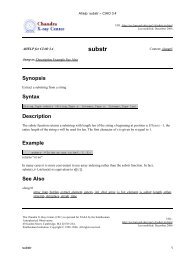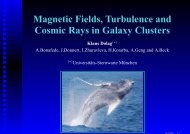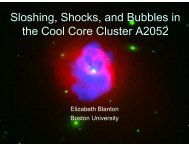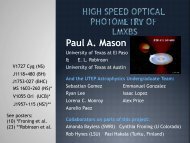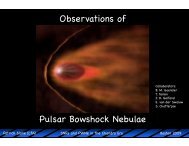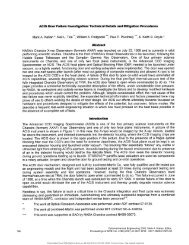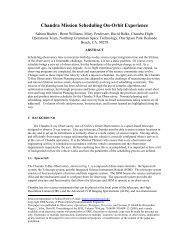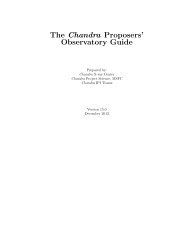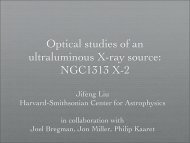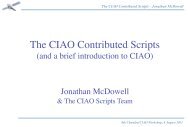PDF Version - Chandra X-Ray Observatory (CXC)
PDF Version - Chandra X-Ray Observatory (CXC)
PDF Version - Chandra X-Ray Observatory (CXC)
You also want an ePaper? Increase the reach of your titles
YUMPU automatically turns print PDFs into web optimized ePapers that Google loves.
Spring, 2012<br />
Listening to X-ray Data<br />
Wanda Diaz Merced, Matt Schnepps, Nancy<br />
S. Brickhouse, G. Juan M. Luna and Stephen<br />
Brewster<br />
Astronomy is thought of as a visual science, but<br />
astronomers have long since exceeded the wavelength<br />
range of the human eye. We find many ways to represent<br />
otherwise invisible data to our senses. If astronomical<br />
data can be represented in diverse ways, the audience for<br />
which the data are useful becomes more diverse, and our<br />
opportunities for conceptualizing the data expand as well.<br />
At Glasgow University we have developed a tool<br />
for rendering space physics data non-visually, through<br />
sonification. Sonification can open up the space physics<br />
data collection to a new community of researchers now<br />
excluded from space physics research, including the visually<br />
impaired. In addition, the sound of many types of astronomical<br />
data allows for a richer intuitive understanding<br />
of it by everyone.<br />
Sonification can benefit all students and researchers,<br />
allowing them to :<br />
• analyze complex or rapidly/temporally changing data.<br />
• explore large datasets (multi-dimensional datasets).<br />
• intuitively explore datasets in the frequency domain.<br />
• identify new phenomena that current display techniques<br />
miss.<br />
Fig. 1 - The xSonify user interface. Any 1-D data set (e.g., timeseries data, or a spectrum)<br />
can be imported into the application. The software will then sonify the data, converting the<br />
visible amplitudes (upper left), into auditory information that can be heard, augmenting the<br />
visual analysis of the data.<br />
31<br />
• find hidden correlations and patterns masked in visual<br />
displays.<br />
• monitor data while doing something else (background<br />
event-finding).<br />
For instance, when searching solar data for bow<br />
shock and magnetopause crossings, we expect that distinctive<br />
signatures will be especially apparent above the<br />
background noise. These boundary signatures appear<br />
as characteristic changes in the whole spectrum. Other<br />
emissions appear as tones at distinctive frequencies or<br />
time-frequency spectra (such as electron plasma oscillations,<br />
magnetic noise bursts in the magnetosheath, and<br />
whistler mode emissions marking regions of currents).<br />
The xSonify tool sonifies 1-dimensional data from<br />
text files and from CDAWeb heliophysics data holdings.<br />
xSonify is based on Java 1.5 with Java Sound, MIDI, JavaSpeech,<br />
WebStart and Web Services technology. xSonify<br />
features three different sonification modes (Pitch, Loudness,<br />
Rhythm) with various controls (Play, Stop, Loop,<br />
Speed, Time point). It includes capabilities for limited<br />
pre-processing of input data (Limits, Invert, Logarithm,<br />
Averaging). We will further enhance xSonify to handle<br />
all 1-dimensional (as well as multi-dimensional) data and<br />
add additional features. The source code is openly available<br />
at http://xsonify.sourceforge.net under the NASA<br />
Open Source Agreement (NOSA).<br />
The non-visual representation of data (sonification),<br />
made possible through this tool began with NASA<br />
support, starting from the Space Physics Data Faciliy<br />
(S<strong>PDF</strong>) requirement to improve access to heliophysics<br />
data. This project will also meet<br />
the goals of contributing to the<br />
development of the science,<br />
technology, engineering, and<br />
mathematics (STEM) workforce<br />
(especially in under-served and<br />
under-represented communities)<br />
[NASA Education Outcome ED-<br />
1] and attract students to STEM<br />
disciplines [NASA Education<br />
Outcome ED-2].<br />
Sonified X-ray Data<br />
EX Hydrae is a southern<br />
variable star classified as an<br />
eclipsing intermediate polar-type<br />
cataclysmic variable (CV) of the<br />
DQ Her type. As a binary with<br />
an orbital period of 98 minutes,<br />
EX Hya belongs to a small group<br />
of intermediate polars with ultrashort<br />
periods. The observed



